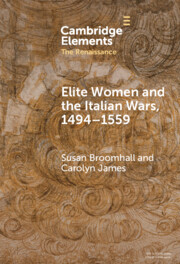Element contents
Elite Women and the Italian Wars, 1494–1559
Published online by Cambridge University Press: 11 January 2024
Summary
- Type
- Element
- Information
- Series: Elements in the RenaissanceOnline ISBN: 9781009415972Publisher: Cambridge University PressPrint publication: 11 April 2024
Bibliography
Primary Sources
Secondary Sources
- 1
- Cited by



